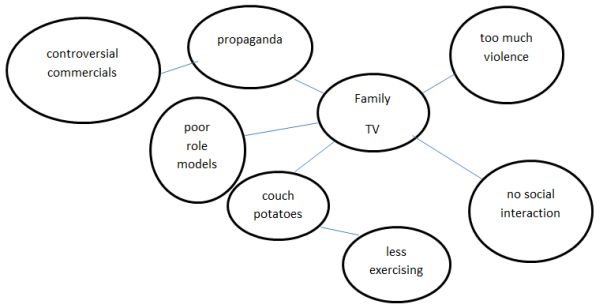Learn
Writing is an essential part of your daily life, and the writing process is a method that allows you to follow steps to improve your writing.
There are also six traits, or qualities, of writing that you should know:
ideas,
organization,
voice,
word choice,
sentence fluency,
and conventions.
Ideas are important, especially in a writing course, but sometimes it is hard to actually come up with a solid idea. This is where the first step in the writing process is needed. Prewriting is a technique used to gather ideas. You must begin with an idea when you write your paper, so that is where step one in the writing process comes in handy. Prewriting helps writers develop or narrow their focus. This is the planning stage of the process where ideas are born. You are finding the purpose and central message of your assignment. You may use a number of prewriting strategies.
Brainstorming is a process of listing information and building from what you have. Write down all topics, terms, etc. to generate ideas.
Clustering is a mapping technique that helps you explore the relationships between ideas. The subject goes in the center of the page, and you branch off from the subject to link to as many new ideas as possible. As new ideas emerge, you link off of those in the same way. Clustering reveals new and unexpected connections.
Freewriting is a strategy where you generate a lot of information by nonstop writing.
Asking questions allows you to pose who, what, where, when, why, and how questions to learn more information.
Outlining gathers information and sorts it into main ideas and supporting details.
Outlining your thoughts helps organize your essay. Here is a sample outline for a three-paragraph essay.
I. Paragraph One: Introduction Hook your audience to topic by providing startling statistics, an anecdote, a quotation, etc. Your thesis statement will be the last sentence in the introduction.
II. Paragraph Two: Body The body provides vivid details supporting the thesis statement.
III. Paragraph Three: Conclusion The conclusion restates your thesis and closes the essay leaving the reader feeling satisfied. You can end with a profound thought, a surprise, a quote, or a challenge.
Are you an organized person? Do you put things in an order that makes sense? Your paragraph or essay should always be organized. Writing is usually organized by space, time, content, or perspective.
The next step in the writing process is drafting. Drafting is where you develop and organize your ideas into paragraphs. A paragraph has a topic sentence that introduces the main idea, three or more supporting details that make up the body, and a conclusion or transition statement that closes the paragraph. Do not begin a new topic unless you start a new paragraph.
Writing should be original and unique to your own experience. Your content should have descriptive details to support the main message. A good writer creates showing sentences instead of telling ones. The aim is for clarity in the details.

Think about the sentence below. How well can you picture this sentence?
Choose the sentence below that is clear and detailed instead of vague and ambiguous.

Does your voice change when you write instead of speak? Well, it's not exactly the same thing. Your speaking voice has pitch and tone that you can actually hear. Your writing voice has tone and style that you can't physically hear, but it comes from within you and readers associate you with a distinct voice. Your voice is coming through the words that you create.
Your authentic voice should show through in each piece that you create. Writers use different techniques to reveal or conceal their voice and personal style. Your voice is a combination of writing styles, perspectives, tones, themes, vocabulary, punctuation, and the way you build your story. Writers use their voice to create emotion and meaning. The better your writing voice is the more human and understandable your writing feels. Your voice and feeling is as important as the plot and characters. Your writing voice is communicated through your naration and your story's point-of-view.
Find Your Writing Voice in Five Steps:
- Choose your point-of-view- You should ask yourself: Why are you writing the story?
- Choose your narrators- For beginners pick a consistent voice and stick to it.
- Choose your word choices and sentence structures- Think about your characters and how they will talk and interact.
- Think about description and dialogue- How much description will you give to the scenes and characters? How will you describe actions and emotions?
- Write as much as possible- Experiment with different writing stykles and voices. Finding your own writing voice takes time. Find what works best for you and your stories.
Plan Your Writing
Use the questions to help you shape your writing:
- Who is my audience?
- What is my purpose for writing?
- What organizational strategies will I use?
- How will I introduce my artifact?
- How will I describe my artifact using sensory language?
- Will I share personal anecdotes, examples, or ideas?
- How will I add cultural context to my writing to help my audience understand my culture?
- What transitions will I use?
- How will I end my writing?
Your voice is just as important as the story. Your voice will write the details that you choose to bring forward in the story. You choose how to tell the story and tell what is happening. Your voice will make a reader feel the characteristics, and events of the story and that will impact their experience.
The words you choose to include in your writing have a huge impact on the reader. This is why revising is such an important part of the writing process. When you revise your writing, you are trying to make the ideas in your paper as clear as possible. Take the sentence below for an example.
The car is fast.
Pretty boring, huh? You don't have enough information about the subject. You know the subject is a noun The word 'car'. the verb is a linking verb The word 'is'. , and predicate adjective The word 'fast'. describes car.
If you want your readers to think the same way you do about the car, you must choose the words carefully to evoke that image to the readers.
Zooming first across the finish line, the car is fast.

The author simply added an introductory participial phrase The phrase 'Zooming first across the finish line.' so that the sentence would be better.
Do you like variety in your life? Many people do. Variety means that there is no monotony; there is change or diversity in what you are doing. Writing is no different. If you have sentence variety, you create different types of sentence patterns, lengths, and rhythms. This provides a flow and helps create a unique voice for you.
You can incorporate variety in your writing by combining sentences to avoid short, choppy sentences. There are four simple steps to good diction.
Varying word choice
Avoiding unnecessary repetition
Choosing words that fit the tone of the writing
Making sure all words mean exactly what they are intended to mean
Examples
Look at the following sentences.
I played tennis. | I hit the ball. | I ran to the net. | I missed the lob.

A man playing tennis.
What do all of these sentences have in common?
When there is no variety in sentence structure, the reader becomes bored and there is no connection to the main idea.
Read the sentence below.
When I played tennis on Saturday afternoon, I smashed the ball to my opponent; running clumsily to the net, I missed the lob her forehand returned to me.
Do you see a difference in structure? Which sentence is smoother?
Writing conventions are the mechanics of writing like spelling, punctuation, capitalization. Usage also plays a part in writing conventions. Usage refers to word choice like verb tense, subject-verb agreement, and pronoun-antecedent agreement. Finding and correcting problems in mechanics is why the fourth stage of the writing process is so important. Editing eliminates mistakes in your paper found in mechanics and usage because you are correcting all of the grammar and punctuation errors you or your peers find.
Let's look at some text exchanges. Can you match the acronyms or abbreviations below to their meanings?
That wasn't hard because you probably write that way a great deal. Teenagers spend most of their time writing in 140 characters or less. No wonder you get confused when trying to write an essay! If you think about to whom you are writing, or your audience, then you will remember to keep the diction either informal or formal.

When you hear the word convention in this lesson, it means the commonly accepted rules of Standard English. When you are examining your writing conventions, you are looking at punctuation, capitalization, spelling, grammar, and neatness.
Don't rely on your computer's spell check for everything.
Eye don't no if ewe halve noticed, butt spell cheque dos knot recognize awl miss steaks.
The last stage of the writing process is called publishing. You have finished all of the work, and now you are ready to present it to your class, teacher, or the world.
